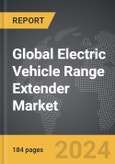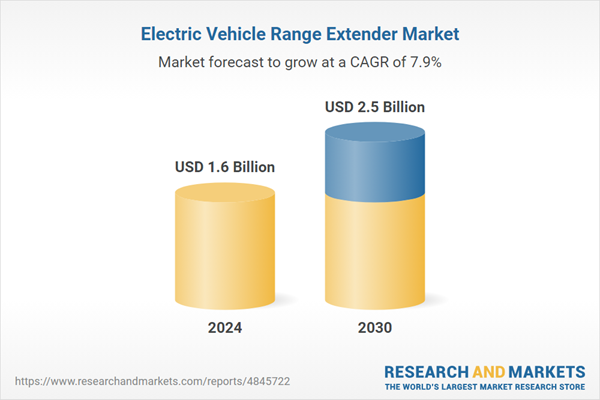The global market for Electric Vehicle Range Extender was valued at US$1.6 Billion in 2024 and is projected to reach US$2.5 Billion by 2030, growing at a CAGR of 7.9% from 2024 to 2030. This comprehensive report provides an in-depth analysis of market trends, drivers, and forecasts, helping you make informed business decisions. The report includes the most recent global tariff developments and how they impact the Electric Vehicle Range Extender market.
Segments: Type (ICE Range Extender, Fuel Cell Range Extender, Other Types); Component (Battery Pack, Electric Motor, Power Converter, Generator); End-Use (Passenger Cars, Commercial Vehicles).
Geographic Regions/Countries: World; United States; Canada; Japan; China; Europe (France; Germany; Italy; United Kingdom; Spain; Russia; and Rest of Europe); Asia-Pacific (Australia; India; South Korea; and Rest of Asia-Pacific); Latin America (Argentina; Brazil; Mexico; and Rest of Latin America); Middle East (Iran; Israel; Saudi Arabia; United Arab Emirates; and Rest of Middle East); and Africa.
The analysts continuously track trade developments worldwide, drawing insights from leading global economists and over 200 industry and policy institutions, including think tanks, trade organizations, and national economic advisory bodies. This intelligence is integrated into forecasting models to provide timely, data-driven analysis of emerging risks and opportunities.
Global Electric Vehicle Range Extender Market - Key Trends and Drivers Summarized
How Are Electric Vehicle Range Extenders Enhancing EV Capabilities?
Electric Vehicle (EV) range extenders are critical innovations that significantly enhance the capabilities of electric cars by addressing one of their most substantial limitations: limited driving range. A range extender is a small combustion engine or additional battery pack that helps increase the distance an EV can travel on a single charge. This technology provides a solution for 'range anxiety,' a common concern among potential EV buyers worried about the availability of charging stations and the possibility of running out of power on longer trips. Range extenders work by either charging the vehicle’s battery when it runs low, thus extending the travel distance before the next recharge, or by acting directly to power the electric motor, thereby conserving battery life. These systems are particularly advantageous in hybrid models where they also offer the flexibility of fuel use when necessary, providing the best of both worlds and making electric vehicles more appealing to a broader audience.What Innovations Are Driving the Development of Electric Vehicle Range Extenders?
Innovation in the field of electric vehicle range extenders is rapidly evolving, driven by advancements in both technology and consumer demand for longer-range EVs. One of the key developments is the improvement of rotary engines, which are compact, lightweight, and can operate at a constant optimal speed to generate electricity efficiently. Another significant advancement is in the use of fuel cell range extenders that utilize hydrogen to produce electricity, offering a zero-emission solution compared to traditional gasoline-powered systems. Additionally, there are ongoing improvements in battery technology, such as the use of lithium-titanate and solid-state batteries, which recharge faster and offer higher energy densities to further extend the driving range. These technological enhancements not only increase the practicality and attractiveness of EVs but also contribute to broader efforts to reduce carbon emissions in the transportation sector.How Do Electric Vehicle Range Extenders Impact Environmental Sustainability?
Electric vehicle range extenders have a complex impact on environmental sustainability. On one hand, they help mitigate range anxiety and enhance the adoption of EVs, which are generally cleaner compared to conventional vehicles. On the other hand, the use of gasoline-powered range extenders introduces emissions that are not present in all-electric systems. However, the net effect tends to be positive as these extenders are typically used only as a backup, meaning that the vehicle runs mostly on electric power. The development of more environmentally friendly range extender solutions, such as those powered by hydrogen fuel cells, presents an opportunity to enjoy extended range without compromising environmental benefits. As technology progresses, the efficiency of these extenders continues to improve, helping to decrease the overall environmental footprint of hybrid vehicles and facilitating a smoother transition from fossil fuels to fully electric solutions.What Trends Are Propelling the Electric Vehicle Range Extender Market?
Several trends are driving growth in the electric vehicle range extender market, including increased investment in EV technology, consumer demand for longer-range vehicles, and evolving environmental regulations. Automotive manufacturers are investing heavily in research and development to create more efficient and compact range extending solutions that can be integrated into various vehicle models. Consumer demand for EVs with extended ranges is also rising, as improved range capabilities make these vehicles more practical for everyday use and long-distance travel. Furthermore, government policies and incentives aimed at reducing vehicular emissions are pushing manufacturers to explore hybrid solutions that incorporate range extenders. This is particularly notable in regions with stringent emissions regulations, where automakers must innovate to meet these challenges. The push towards electrification, coupled with the hybrid approach offered by range extenders, is creating robust opportunities for growth in this market, ensuring that EVs can meet a wider range of consumer needs and driving habits.Report Scope
The report analyzes the Electric Vehicle Range Extender market, presented in terms of units. The analysis covers the key segments and geographic regions outlined below.Segments: Type (ICE Range Extender, Fuel Cell Range Extender, Other Types); Component (Battery Pack, Electric Motor, Power Converter, Generator); End-Use (Passenger Cars, Commercial Vehicles).
Geographic Regions/Countries: World; United States; Canada; Japan; China; Europe (France; Germany; Italy; United Kingdom; Spain; Russia; and Rest of Europe); Asia-Pacific (Australia; India; South Korea; and Rest of Asia-Pacific); Latin America (Argentina; Brazil; Mexico; and Rest of Latin America); Middle East (Iran; Israel; Saudi Arabia; United Arab Emirates; and Rest of Middle East); and Africa.
Key Insights:
- Market Growth: Understand the significant growth trajectory of the ICE Range Extender segment, which is expected to reach US$2.0 Billion by 2030 with a CAGR of a 8.5%. The Fuel Cell Range Extender segment is also set to grow at 5.7% CAGR over the analysis period.
- Regional Analysis: Gain insights into the U.S. market, valued at $410.3 Million in 2024, and China, forecasted to grow at an impressive 11.8% CAGR to reach $635.5 Million by 2030. Discover growth trends in other key regions, including Japan, Canada, Germany, and the Asia-Pacific.
Why You Should Buy This Report:
- Detailed Market Analysis: Access a thorough analysis of the Global Electric Vehicle Range Extender Market, covering all major geographic regions and market segments.
- Competitive Insights: Get an overview of the competitive landscape, including the market presence of major players across different geographies.
- Future Trends and Drivers: Understand the key trends and drivers shaping the future of the Global Electric Vehicle Range Extender Market.
- Actionable Insights: Benefit from actionable insights that can help you identify new revenue opportunities and make strategic business decisions.
Key Questions Answered:
- How is the Global Electric Vehicle Range Extender Market expected to evolve by 2030?
- What are the main drivers and restraints affecting the market?
- Which market segments will grow the most over the forecast period?
- How will market shares for different regions and segments change by 2030?
- Who are the leading players in the market, and what are their prospects?
Report Features:
- Comprehensive Market Data: Independent analysis of annual sales and market forecasts in US$ Million from 2024 to 2030.
- In-Depth Regional Analysis: Detailed insights into key markets, including the U.S., China, Japan, Canada, Europe, Asia-Pacific, Latin America, Middle East, and Africa.
- Company Profiles: Coverage of players such as Advanced Innovative Engineering Ltd., Arcola Energy Ltd., Ashwoods Electric Motors Limited, AVL List GmbH, Ballard Power Systems, Inc. and more.
- Complimentary Updates: Receive free report updates for one year to keep you informed of the latest market developments.
Some of the 22 companies featured in this Electric Vehicle Range Extender market report include:
- Advanced Innovative Engineering Ltd.
- Arcola Energy Ltd.
- Ashwoods Electric Motors Limited
- AVL List GmbH
- Ballard Power Systems, Inc.
- Bjorksten Bit 7 (bb7)
- BMW AG
- Ceres Power Holdings PLC
- Delta Motorsport Ltd.
- EP Tender
- Fagor Ederlan Group
- FEV Group
- General Motors Company
- Horizon Fuel Cell Technologies Pte Ltd.
- Magna International, Inc.
- MAHLE Aftermarket, Inc.
- Mazda Motor Corporation
- Nikola Motor Company
- Nissan Motor Co., Ltd.
- OBRIST Powertrain GmbH
- Plug Power Inc.
- Rheinmetall AG
- Symbio
- Wrightspeed
Tariff Impact Analysis: Key Insights for 2025
Global tariff negotiations across 180+ countries are reshaping supply chains, costs, and competitiveness. This report reflects the latest developments as of April 2025 and incorporates forward-looking insights into the market outlook.The analysts continuously track trade developments worldwide, drawing insights from leading global economists and over 200 industry and policy institutions, including think tanks, trade organizations, and national economic advisory bodies. This intelligence is integrated into forecasting models to provide timely, data-driven analysis of emerging risks and opportunities.
What’s Included in This Edition:
- Tariff-adjusted market forecasts by region and segment
- Analysis of cost and supply chain implications by sourcing and trade exposure
- Strategic insights into geographic shifts
Buyers receive a free July 2025 update with:
- Finalized tariff impacts and new trade agreement effects
- Updated projections reflecting global sourcing and cost shifts
- Expanded country-specific coverage across the industry
Table of Contents
I. METHODOLOGYII. EXECUTIVE SUMMARY2. FOCUS ON SELECT PLAYERSIII. MARKET ANALYSISSOUTH KOREAREST OF ASIA-PACIFICARGENTINABRAZILMEXICOREST OF LATIN AMERICAIRANISRAELSAUDI ARABIAUNITED ARAB EMIRATESREST OF MIDDLE EASTIV. COMPETITION
1. MARKET OVERVIEW
3. MARKET TRENDS & DRIVERS
4. GLOBAL MARKET PERSPECTIVE
UNITED STATES
CANADA
JAPAN
CHINA
EUROPE
FRANCE
GERMANY
ITALY
UNITED KINGDOM
SPAIN
RUSSIA
REST OF EUROPE
ASIA-PACIFIC
AUSTRALIA
INDIA
LATIN AMERICA
MIDDLE EAST
AFRICA
Companies Mentioned (Partial List)
A selection of companies mentioned in this report includes, but is not limited to:
- Advanced Innovative Engineering Ltd.
- Arcola Energy Ltd.
- Ashwoods Electric Motors Limited
- AVL List GmbH
- Ballard Power Systems, Inc.
- Bjorksten Bit 7 (bb7)
- BMW AG
- Ceres Power Holdings PLC
- Delta Motorsport Ltd.
- EP Tender
- Fagor Ederlan Group
- FEV Group
- General Motors Company
- Horizon Fuel Cell Technologies Pte Ltd.
- Magna International, Inc.
- MAHLE Aftermarket, Inc.
- Mazda Motor Corporation
- Nikola Motor Company
- Nissan Motor Co., Ltd.
- OBRIST Powertrain GmbH
- Plug Power Inc.
- Rheinmetall AG
- Symbio
- Wrightspeed
Table Information
| Report Attribute | Details |
|---|---|
| No. of Pages | 184 |
| Published | April 2025 |
| Forecast Period | 2024 - 2030 |
| Estimated Market Value ( USD | $ 1.6 Billion |
| Forecasted Market Value ( USD | $ 2.5 Billion |
| Compound Annual Growth Rate | 7.9% |
| Regions Covered | Global |









